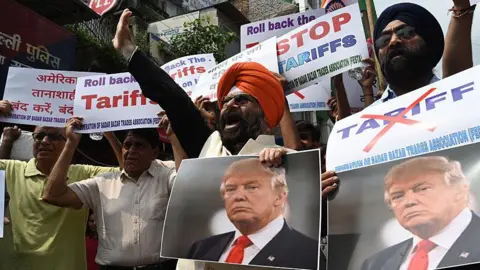India chooses geopolitical signals and export support instead of direct retaliation to US 50% tariffs
Tariffs took effect 27 August as trade talks stalled; analysts warn prolonged measures could shave up to 0.8% off India's GDP
The 50% tariffs imposed by US President Donald Trump on Indian goods took effect on 27 August, but New Delhi has so far eschewed direct trade retaliation and instead deployed diplomatic and domestic economic measures to signal displeasure and try to blunt the impact.
Rather than immediately imposing reciprocal duties or launching a trade dispute, Indian leaders have pursued a carefully staged geopolitical response and measures to support exporters at home. Prime Minister Narendra Modi has been visible in engagements with other major powers, and Delhi has announced short-term assistance for affected firms and is weighing tax cuts to help exporters cope with the higher US tariffs.

The tariffs have strained a relationship that was already under pressure. Trade negotiations between Washington and New Delhi have halted, and Indian officials say the ties have frayed further amid repeated public admonishments from US authorities. India, which counts the United States among its largest trading partners, faces potential economic pain if the duties remain in place for an extended period.
Analysts have warned that prolonged 50% tariffs could reduce India's economic output by as much as 0.8% of gross domestic product, a figure New Delhi must weigh against the political and strategic costs of escalating a trade spat with Washington. Officials in Delhi are balancing those economic calculations with broader strategic considerations, including deepening ties with other global powers.
Delhi's diplomatic posture in recent weeks has included outreach to Beijing and high-profile meetings with leaders such as Russian President Vladimir Putin. Images of Mr. Modi sharing a limousine ride with Mr. Putin at a security forum in Tianjin circulated widely and were framed by Indian officials as part of efforts to diversify New Delhi's strategic partnerships and convey a message to Washington.
On the economic front, the government has offered relief measures aimed at exporters contending with sudden, higher tariffs from their largest overseas market. Those steps have included temporary financial support and promises of prospective tax relief to help firms manage cash-flow disruptions and maintain competitiveness. Indian industry groups have urged more targeted measures and faster implementation to prevent export orders from migrating to competing suppliers.
New Delhi's caution reflects the complexity of a bilateral relationship that spans defence cooperation, technology and investment flows, and a large diaspora in the United States. Officials have argued that retaliatory tariffs could damage Indian firms as much as they would harm US exporters, especially in sectors tightly integrated into global supply chains.
Some trade experts say India does retain options if it chooses to pursue them, including reciprocal tariffs, selective trade restrictions or legal challenges at multilateral forums, but New Delhi's current posture indicates a preference for de-escalation and mitigation rather than an immediate tit-for-tat response.
The timing and duration of Washington's tariffs will shape New Delhi's next moves. With negotiations stalled and public rhetoric from both sides remaining sharp, businesses in export-oriented sectors say uncertainty is already affecting investment decisions and order books. The Indian government has said it will continue exploring diplomatic and economic avenues to protect national interests while seeking to avoid a prolonged bilateral trade confrontation.
For now, the dispute marks a fresh test of the US-India relationship, with both economic and geopolitical repercussions. How long the tariffs remain and whether New Delhi shifts from its current strategy of strategic signalling and domestic relief to more direct trade measures will determine the dispute's economic toll and its wider impact on bilateral ties.